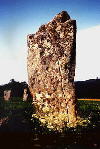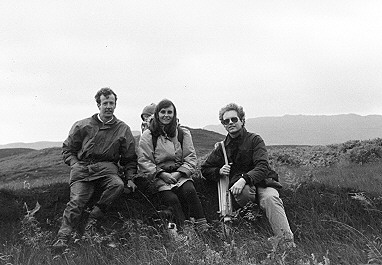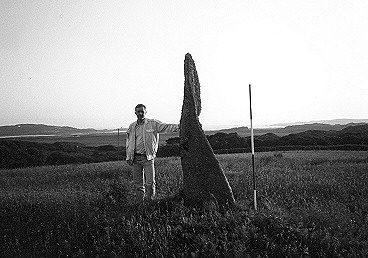
Postscript
Stones
of Wonder
QUICK LINKS ...
HOME PAGE
INTRODUCTION
WATCHING
THE SUN, MOON AND STARS
THE
MONUMENTS
THE
PEOPLE AND THE SKY
BACKGROUND
ARCHAEOASTRONOMY
USING
THE SITE DESCRIPTION PAGES
VISITING
THE SITES
THE
LEY LINE MYSTERY
THE
SITES
ARGYLL
AND ARRAN
MID
AND SOUTH SCOTLAND
NORTH
AND NORTH-EAST SCOTLAND
WESTERN
ISLES AND MULL
Data
DATES
OF EQUINOXES AND SOLSTICES, 1997 to 2030 AD
DATES
OF MIDSUMMER AND MIDWINTER FULL MOONS, 1997 to 2030 AD
POSTSCRIPT
Individual
Site References
Bibliography
Links
to other relevant pages
Contact
me at : rpollock456@gmail.com
POSTSCRIPT
The meaning of the stones?
 The
most striking impression most visitors get from a stone circle, alignment
or standing stone is likely to be one of endurance. The stones have stood
for four or five thousand years, unchanging in themselves as the world
changed around them. These stones stood before we were born, stand now,
and will be there in the landscape long after we have departed.
The
most striking impression most visitors get from a stone circle, alignment
or standing stone is likely to be one of endurance. The stones have stood
for four or five thousand years, unchanging in themselves as the world
changed around them. These stones stood before we were born, stand now,
and will be there in the landscape long after we have departed.
Such considerations impel modern humans to plan for their own gravestones, which will carry their name onwards in time for a little while longer, and it was natural that the interpretation of the ancient standing stones as grave or battle memorials should arise in the 19th century. But as has been shown, some if not most of the stones were erected with a broader and more esoteric purpose. But the interpretation of the stones as astronomical markers will probably leave many people unsatisfied. A true appreciation of the sites somehow needs more than this.
Whatever way we personally wish to appreciate the stones, at least it is clear what they mean to various individuals of different interests today - enduring monuments of a past age and way of life, to be protected and appreciated, remnants of an ancient calendar system, traces of a golden, pre-technological age, the constructs of a priestly upper class, places of sacrifice and dread or places to worship the nature gods of the New Age.
These ideas are of our own time, inescapably. But what did the stones mean to our ancestors in the Stone Age or Bronze Age, the people who struggled to clear the land, quarry the stones and erect them in particular places ? We have no written records of theirs to tell us their thoughts and aspirations. We have no comments about the society from other literate civilizations as exist for example in the Celtic period, where Roman writers left a series of first hand accounts (even naming individual Celtic leaders). Only the stones, and other structures and artefacts recovered by archaeology have come down to us. Through archaeological techniques such as survey and excavation we have a hazy picture of the areas of settlement, the basis of the economy and the level of technology of our ancestors in the distant past.
Analysis of soil deposits and bones provides some information about diet and mortality, and chronometric dating techniques such as the radiocarbon method can give the approximate date of death of once living material.
Modern day anthropologists can visit and live among such simple societies as still survive, to record and understand their kinship systems, religions and ceremonial ; these workers can interpret the tribe's understanding of the universe, be told their legends and participate in their culture. But such methods are not available to us in our attempts to appreciate our own ancestors, where only some small fraction of the physical remains of their time survive. The language they spoke is itself lost. Such folklore as exists concerning the stones reflects the views of a much later literate and Christian heritage.
So when it comes to the thoughts and motivations of the builders of the megaliths are we left only with speculation and guesswork? There is plenty of this to be had. An attempt has been made in the Web guidebook to remain objective, to present the facts known about the standing stones and the data derived from surveys, to allow the visitor to appreciate the stones with the necessary information to hand. Hopefully the reader will have visited some of these sites now, and the following observations may have more meaning.
It is often commented that the idea of infinity is not really encompassable by the human mind, the word is just a handle for a concept which is beyond true human comprehension. But our languages are really much more restrictive than that. We can sit beside a standing stone on the moor and know archaeologists believe that it was erected about 2,500BC. What does this mean? It means four and a half thousand years ago. This is the same as forty-five centuries. If a human reproduces at about 25 years of age then this means that one hundred and eighty generations have passed since that time. So it could have been put up by my grandmother's grandmother's grandmother's.....? Or if I live to be 75, this stone already has sixty lifetimes on me. Sixty lifetimes? And so it all breaks down. Sixty lifetimes in a row is really no different to infinity, it is utterly outside the normal social frame of reference.
 So
we have the irony that although it is the agedness and endurance of the
standing stones which is so fascinating, it is a fascination naturally
conscribed. We can only really respond to the stones in the context of
our own lives and sensibilities, which is after all what makes the experience
of a sunrise or sunset meaningful. People interested in these monuments
are sometimes compelled to erect a standing stone or even a circle in
their own gardens. It is as if the universe is somehow brought to notice
the short-lived individual by doing so. This may be the faint line which
leads us somewhere into universal human experience, where time is irrelevant.
A stone is erected, it stands pointing to the horizon all year round.
One day of the year it marks a point in the cycle of the sun or the moon
- a ceremony can then take place. The person who erected the stone dies.
The tribe still celebrates at the stone every year. The stone stands.
The tribe fades away, the land is empty, time passes. New people appear.
The stone still stands pointing to the horizon. Now the new people on
the land accept the stone as part of their environment, part of their
present natural world, even though erected at some forgotten distant time.
The stone is still present, still functions, the sense of awe at the dance
of the earth, sun and moon can still be felt.
So
we have the irony that although it is the agedness and endurance of the
standing stones which is so fascinating, it is a fascination naturally
conscribed. We can only really respond to the stones in the context of
our own lives and sensibilities, which is after all what makes the experience
of a sunrise or sunset meaningful. People interested in these monuments
are sometimes compelled to erect a standing stone or even a circle in
their own gardens. It is as if the universe is somehow brought to notice
the short-lived individual by doing so. This may be the faint line which
leads us somewhere into universal human experience, where time is irrelevant.
A stone is erected, it stands pointing to the horizon all year round.
One day of the year it marks a point in the cycle of the sun or the moon
- a ceremony can then take place. The person who erected the stone dies.
The tribe still celebrates at the stone every year. The stone stands.
The tribe fades away, the land is empty, time passes. New people appear.
The stone still stands pointing to the horizon. Now the new people on
the land accept the stone as part of their environment, part of their
present natural world, even though erected at some forgotten distant time.
The stone is still present, still functions, the sense of awe at the dance
of the earth, sun and moon can still be felt.
Acknowledgments.
I would like to thank the following people who helped during the creation of this guidebook :
Mary Butler, Ian Scott and Tom Ramsay, who assisted with site surveys ; Jane Brann, Frances Hood and Roz and Andy Summers who offered information and constructive criticism ; Jane Brann also supplied the photo of the Drumtroddan alignment, and Frances Hood the photo of sunrise at Brainport Bay ; the staff of Pentax Surveying supplies, Glasgow who provided the theodolite used in the surveys ; the staff of the National Monument Record of Scotland and the RCAHMS who provided information and references ; and the many farmers and landowners who granted access to sites on their land.
Acknowledgements are also due to Derek Rodger of Argyll Publishing who suggested the title of the guidebook and who inspired the creation of this web guide. Thanks a real lot, Derek.
The author would be interested to hear of the reader's skywatching experiences at any of these sites or any other orientated prehistoric sites in Scotland or elsewhere. Dated photos or slides of sunrises etc. would be also be appreciated. Please email me. Thanks!

